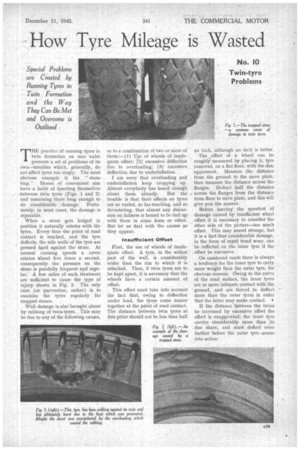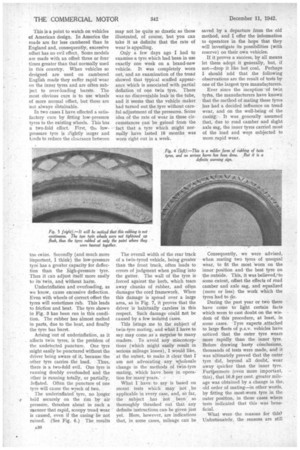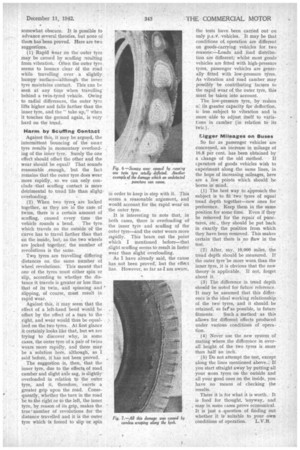How Tyre Mileage is Wasted
Page 31

Page 32

Page 33

If you've noticed an error in this article please click here to report it so we can fix it.
THE practice of running tyres in twin formation on rear axles . presents a set of problems of its own—troubles which, generally, do not affect tyres run singly. The most obvious example is the "stone trap." Stones of convenient size have a habit of inserting themselves -between twin tyres (Figs. 1 and 2) and remaining there long enough to do considerable damage. Fortunately, in most cases, the damage is reparable.
When a stone gets lodged in position it naturally rotates with the tyres. Every time the point of road contact is reached, and the tyre deflects, the side walls of the tyre are pressed hard against the stone. At normal cruising speeds a cover rotates 'about five times a second, consequently the pressure on the stone is painfully frequent and regular. ' A few miles of such treatment are sufficient to cause the type of injury shown in Fig. 2. The only cure (or prevention, rather) is to examine the tyres regularly for trapped stones.
Wall damage is also brought about by rubbing of twin i tyres. This may be-due to any of the following causes,
or to a combination of two or more of them:—(l ) Use of wheels of inadequate offset; (2) excessive deflection due to overloading; (3) excessive deflection due to underinflation.
I am sorry that overloading and underinflation keep cropping up. Almost everybody has heard enough about them already. But the trouble is that their effects on tyres are so varied, so far-reaching, and so devastating, that almost any discussion On failures is bound to be tied up with them in some form, or other. But -let us deal with the causes as they appear.
Insufficient Offset
First, the use of wheels of -inadequate offset. A tyre, in the widest part of the wall, is considerably wider than the rim to which it is attached. Thus, if twin tyres are to be kept apart, it is necessary that the wheels have a certain amount of offset.
This offset must take into account the fact that, owing to deflection under load, the tyres come nearer together at the point of road contact The distance between twin tyres at this point should not be less than half
an inch, although an inch is better. The ..,offset of a wheel can be roughly measured by placing it, tyre removed, on a flat floor, with the disc uppermost. Measure the distance from the ground to the nave plate, then measure the distance across the flanges. Deduct half the distance , across the flanges from the distance from floor to nave plate, and this will give you the answer. Before leavingthe question of damage caused by insufficient wheel offset it is necessary to consider the Other side of the picture—too much offset. This may sound strange, but it is a fact that considerable damage, in the form of rapid tread wear, can be -inflicted on the inner tyre if the -Offset be excessive.
On cambered roads there is always a tendency for the inner tyre to carry more weight than the outer tyre, for obvious reason's. Owing to the curve of the road surface, the inner tyres are in more intimate contact with the ' ground, and are forced to deflect more than the outer tyres in order that the latter may make contact. •
If the distance between the twins be increased by excessive offset the effect is exaggerated; the inner tyre carries eensiderably more than its -due share, and must deflect even further before the outer tyre. comes into action.
This is a point to watch on vehicles of American design. In America the roads are far less cambered than in England and, consequently, excessive offset has no evil effect. Some models are made with an offset three or four times greater than that normally used in this country. When vehicles so clesived are used on cambered English roads they suffer rapid 'wear on the inner tyres and are often subject to over-loading bursts, The most obvious cure is to use wheels of more normal offset, but these are not always Obtainable.
In two cases I have effected a satisfactory cure by fitting low-pressure tyres to the existing wheels. This has a two-fold effect. First, the lowpressure tyre is slightly larger and tonds to reduce the clearance between tne twins. Secondly (and much more iinportant, I think) the low-pressure tyre has a greater capacity for deflection than the high-pressure tyre. Thus it can adjust itself more easily to its twin, and without harm.
Underinflation and overloading, as we know, cause excessive deflection. Even with wheels of correct offset the tyres will soinetimes rub. This leads to friction and heat. The tyre shown in Fig. 3 has been run in this condition. The rubber has almost melted in parts, due to the heat, and finally the tyre has burst.
Arising out of underinflation, as it affects twin tyres, is the problem of the undetected puncture. One tyre might easily be punctured without the driver being aware of it, because the other tyre carries the load. Thus, there is a two-fold evil. One tyre is running doubly overloaded and the other is running totally, or partially, deflated. Often the puncture of one tyre will cause the wreck of two.
The underinfinted tyre, no longer held securely on the rim by air pressure, thrashes about in such a manner that rapid, scoopy tread wear is caused, even if the casing be not ruined. (See Fig. 6.) The results ma..y not be quite so drastic as those illustrated, of course, but you can take it as definite that the rate of wear is appalling.
On,ly a few days ago I had to examine a tyre which had been in use exactly one week on a brand-new vehicle. It was completely worn out, and an examination of the tread showed that typical scuffed appearance which is associated with partial deflation of one twin tyre. There was no discoverable leak in the tube, and it seems that the vehicle maker had turned out the tyre without careful adjustment of the pressures. Some idea of the rate of wear in these circumstances can be gained from the —fact that a tyre which might normally have lasted 18 months was worn right out in a week.
The overall width of the rear track of a twin-tyred vehicle, being greater than the front track, often leads to errors of judgment when pulling into the gutter. The wall of the tyre is , forced against the kerb, which tears away chunks of rubber, and often damages the cord framework. When this damage is spread over a large area, as in Fig. 7, it proves that the driver is habitually careless' in this respect. Such damage could not be caused by a few isolated cases.
This brings me to the subject of twin-tyre mating, and what I have to say may come as a surprise to many readers. To avoid any misconceptions (which might easily result in serious mileage losses), I Would like, at the outset, to make it clear that I am not advocating any wholesale change in the methods of twin-tyre mating, which have been in operation for many years.
What I have to say is based on recent tests which may not , be applicable in every case, and, so .far, the subject has not . been so thoroughly thrashed out that any definite instructions can be given just yet. Here, however, are indications that, in some cases, mileage can be
saved by a departure from the old method, and I offer the information to operators in the hope that they -will investigate its possibilities (with reserve) on their own vehicles.
If it proves a success, by all means let them 'adopt it generally, but, if not—drop it like hot coal. Perhaps I should add that the following observations are the result of tests by one of the largest tyre manufacturers.
Ever since the inception of twin tyfes, the manufacturers have known that the method of mating these tyres has had a decided influence on tread wear, and on the well-being of the casingIt was generally assumed that, due to road camber and slight axle sag, the inner tyres carried most of the load and were subjected to more rapid wear.
Consequently, we were advised, when mating two tyres of unequal wear, to fit the most worn on the inner position and the best tyre on the outside. This, it was believed,' to some extent, offset the effects of road camber and axle sag, and equalized (more or less) the work which the tyres had to ctn.
During the past year or two there have come to light certain facts which seem to cast doubt on the wisdom of this procedure, at least, in some cases. Tyre experts _attached to large fleets of p.s.v. vehicles have noticed that the outer tyre wears more rapidly than the inner tyre. Before drawing hasty conclusions, thousands of tests were made, and it was ultimately proved that the outer tyre did, beyond all doubt, wear away quicker than the inner tyre. Furttiermore (even more important, this), that 16.8 per cent. greater mileage was obtained by a change in the, old order of mating—in other woeds, by fitting the most-worn tyre in the outer position, in those cases where tests indicated that this was beneficial.
What were the reasons for this? Unfortunately, the reasons are still somewhat obscure. It is possible to advance several theories, but none of them has been proved. Here are two suggestions. • (I) Rapid wear on the outer tyre may be caused by scuffing :eaulting from vibration. Often the outer tyre seems to bounce clear Of the road while travelling over a slightly bumpy surface—although the inner tyre maintains contact. This can tet seen at any time when travelling behind a twin-tyred vehicle. Owing to radial differences, the outer tyre lifts higher and falls farther than the inner tyre, and the " take up," when it touches the ground again, is very hard on the tread.
Harm by Scuffing Contact Against this, it may be argued, the intermittent bouncing of the our tyre results in momentary overloading of the inner tyre. Surely the one effect should offset the other and the wear should be equal? That sounds reasonable enough, but the fact remains that the outer tyre does wear more rapidly, so we can only conclude that scuffing contact is more detrimental to tread life than sligh,t overloading.
(2) When two tyres. are locked together, as they are in the case of twins, there is a certain amount of scuffing, caused every time the vehicle rounds a bend. The tyre which travels on the outside of the curve has to travel farther than that on the inside, but, as the two wheels are locked together; the number of revolutions is the same.
Twn tyres are travelling differing distances on the same number of wheel revolutions. This means that one of the tyres must either spin or slip, according to whether the distance it travels is greater or less than that of its twin, and spinning and slipping, of course, must result in rapid wear.
Against this, it may seem that the effect of a left-hand bend would be offset by the effect of a turn to the right, and wear would thus be equalized on the two tyres. At first glance it certainly looks like that, but we are trying to discover why, in some cases, the outer tyre of a pair of twins wears more rapidly, and there may be a solution here, although, as I said before, it has not been proved.
The suggestion is, then, that the inner tyre, due to the effect* of road camber and slight axle sag, is slightly overloaded in relation tp the outer tyre, and it, therefore, exerts a greater grip upon the road. Consequently,, whether the turn in the road be to the right or to the left, the inner, tyre, by reason of its grip, makes the true •number of revolutions for the distance travelled and it is the outer tyre which is forced to slip or spin
in order to keep in step with it. This seems a reasonable argument,. and would account for the rapid wear on the outer tyre.
It is interesting to note that, in both cases, there is overloading of the inner tyre and scuffing of the outer tyre—and the outer wears more rapidly. This bears out the point which I mentioned before—that slight scuffing seems to result in faster wear than slight overloading, As I have already said, the cause has not been proved, but the effect has. However, so far as-I am aware, the tests have been carried out on only p.s./. vehicles. It may be that conditions of. operation are different on goods-carrying vehicles for two reasons:—Loads and lbad distribution are different; whilst most goods vehicles are fitted with high-pressure tyres, passenger vehicles are generally fitted with low-pressure t3ires. As vibration and road camber may possibly be contributing factors to the rapid wear of the outer tyre, this must be taken into account.
The low-pressure tyre, by reAon o.! its greater capacity for deflection, is less subject to vibration and is more able to adjust itself to variatons in camber (in relation to its Eigger Mileages on Buses
So far as passenger vehicles are concerned, an increase in mileage of 16.8 per cent. has been obtained by
a change of the old method. If cperatorS of goods vehicles wish to experiment along .the same lines, in the hope of increasing mileages, here are a few points which should be borne in mind.
(1) The best way to a`pproach the subject is to fit two tyres of equal tread depth together—new ones for preference. Keep them in the same position for some time. Even if they be removed for the repair of punctures, etc., they should be put back in exactly the position from which they have been removed. This makes certain that there is no flaw in the test. • (2) After, say, 10,000 miles, the tread depth should be measured. If
• the outer tyre-be more worn than the inner tyre, it is obvious that the new theory is applicable. If not, forget about it.
(3) The difference in tread depth should be noted for future reference. It may be assumed that this difference is the ideal working relationship. of the two tyres, and it should be retained, so faras possible, in future fitments. Such a method as this allows for different effects produced under various conditions of operation.
(4) Never use the new system of mating where the difference in overall height of the two tyres is more than half an inch.
(5) Do not attempt the test, except along the lines mentioned above..; If you start straight away by putting all your worn tyres on the outside and all your good ones on the inside, you have no means of checking the • results.
There it is for what it is worth. It is food for thought, 'anyway, and may in some cases prove economical. It is just a question of fixiding out whether it is suitable to your ciiirn conditions of operation. L.V.B.




















































